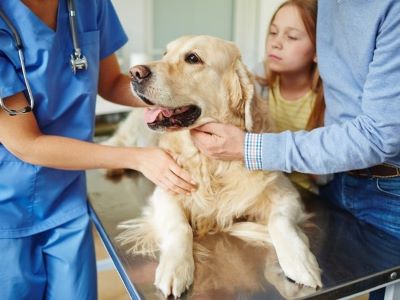You are feeling happy as your dog is showing signs of pregnancy, but it is quite possible that it is phantom pregnancy, now what is phantom pregnancy in dogs?
Let’s understand what is phantom pregnancy, what the causes are and what we can do to prevent it in order to give our dogs a healthy and happy life.

What is Phantom Pregnancy in Dogs?
Phantom pregnancies are also known as false pregnancies or pseudopregnancies in dogs. When a female dog is displaying symptoms of pregnancy she is not actually carrying the puppies. This can be confusing to the pet owners as this is also something natural that happens a lot with dogs.
The exact cause is unknown but certain breeds like retrievers seem more prone to phantom pregnancies. They can occur after a heat cycle or after mating with a male dog that does not result in pregnancy. Phantom pregnancies are also caused by hormonal changes in the dog’s body.
"When a female dog goes through her heat cycle (also known as estrus), her hormone levels fluctuate. Sometimes, even if she hasn't mated with a male dog, her body can react as if she's pregnant. This hormonal imbalance tricks her body into thinking it's expecting puppies" confirms Malcolm Weir at VCA Hospitals.
This condition is common among unspayed female dogs around their heat cycle and it is possible for your dog to show these signs when you spay them during the heat cycle.

It usually lasts 2-3 weeks from the start of symptoms[1] and goes away on its own. If you still feel concerned then you must consult with your vet about your dog’s specific condition.
Difference Between False and Real Pregnancy
Let’s understand how real and false pregnancy differs:
| Factors | False(Phantom) Pregnancy | Real Pregnancy |
|---|---|---|
| Cause | Hormonal changes in the body. | Successful mating with a male dog. |
| Time | Typically 2-3 weeks. | Approximately 63 days. |
| Signs | Nesting, motherly behaviour, breast enlargement with milk production, changes in appetite, weight gain, and lethargy. | Increased appetite, weight gain, changes in behaviour. |
| Puppies | No actual puppies. | Actual puppies will be born |

Symptoms of Phantom Pregnancy in Dogs
There are noticeable changes that happen in phantom pregnancy that make you believe that your dog is really pregnant. Let’s look at some reasons[2]:
The dog’s mammary glands become enlarged and may even produce milk. This happens because of hormonal changes in the body. While there are no puppies, fluid buildup in the abdomen can sometimes cause a slight swelling or enlargement.
- Dogs may gain weight during a phantom pregnancy from fluid accumulation in the abdomen and enlargement of breast tissue. The weight gain is not from puppies growing.
- A dog experiencing a phantom pregnancy may gather items like blankets, towels or toys to create a nest. This mimics the nesting instinct a pregnant dog would have. She may show mothering behaviours like carrying around or trying to nurse on a toy.
- Some dogs lose their appetite during a phantom pregnancy, just like a real pregnant dog may experience a decrease in appetite close to delivery. Less energy and more restfulness are common during a phantom pregnancy, similar to a real pregnant dog conserving energy.
The hormonal changes may cause clingy or needy behaviour in some dogs as they experience false signs of motherhood.

What to Do in Phantom Pregnancies?
If you suspect that your dog has a false pregnancy or if you are confused about the signs then you must consult with the vet as they will examine your dog and guide you about the symptoms.
The simplest way is to run a canine pregnancy test. A relaxin test can reveal pregnancy in the early stages. If your dog is further along in her pregnancy or pseudopregnancy (about 20–22 days in), your vet can do an ultrasound to look for fetuses.
By day 28, the vet should be able to feel pups in her belly if she's pregnant then by day 52, the puppies can be seen on abdominal X-rays. Let's see what can you do if your dog is experiencing these symptoms:
- Give your dog some extra comfort like a warm bed, soft blankets, or toys to nurture. This can help satisfy the nesting instinct.
- Avoid rubbing the dog’s belly and prevent access to toys or objects the dog may try nursing on. This tactile stimulation can worsen phantom symptoms.
- Gentle walks and playtime can help relieve restlessness from lower energy levels. But don’t overdo it. Notice if your dog loses interest in food and is tempted by tasty treats.

- If your dog tries gathering or nursing toys, substitute them with another activity to redirect the maternal behaviours. If breasts become engorged or swollen, your vet may prescribe medication to reduce milk production.
Make sure your dog maintains a healthy diet with proper nutrition if signs last longer than 2-3 weeks. Provide comfort, and rule out underlying issues!
Preventing Phantom Pregnancy in Dogs
Yes, it is possible to prevent this condition in female dogs. By understanding the hormones involved and taking into account every dog we can prevent this situation, let’s see how:
1. Spaying
Keep female dogs away from intact males when in heat. Breeding can trigger hormone changes even if no pregnancy occurs. The more heat cycles a female dog goes through, the higher her chances of having a phantom pregnancy.
And if you don’t want to breed then spaying is the most effective way to prevent phantom pregnancies in your female dog. This involves removing the ovaries and sometimes the uterus.
This surgery stops the hormonal changes that trigger false pregnancies. Most dogs that are spayed before their first heat cycle are less likely to experience phantom pregnancies.

2. Wait and Observe
If you’re not planning to breed your dog, consider waiting to spay her until after her first heat cycle. This allows her to go through one heat cycle, which may help in her physical and emotional development.
After the first heat, consult with your vet about the timing of the spaying procedure. If your unspayed dog shows nipple enlargement, nesting behaviour, weight gain or other odd signs after a heat cycle, contact your vet about possible false pregnancy.
3. Hormonal Activity
Sometimes your vet may specify hormone-inhibiting medications to help manage the hormonal imbalances that lead to phantom pregnancies.
These medications are typically used when spaying is not an option.

4. Keep Objects Away
During your dog's heat cycle, try to keep objects that she might "mother" away from her. This can reduce the likelihood of her becoming attached to items, which is a common symptom of phantom pregnancies.
Be cautious with playing mothering/nursing games. Providing stuffed animal “puppies” or excessive belly rubs can encourage maternal behaviours.
FAQs
1. What Causes Phantom Pregnancy in Dogs?
After every season or heat, there are hormonal changes which prepare a bitch’s body for pregnancy, even though they are not pregnant. This may be because naturally, dogs would live in groups and the more female dogs that can help with puppies the better.
2. What is Phantom Pregnancy in Dogs?
False pregnancy, phantom pregnancy, pseudo-pregnancy or pseudocyesis are all terms that refer to a display of maternal (mothering) behaviour combined with the physical signs of pregnancy following estrus (“heat”) in an unspayed female dog that is not actually pregnant.
3. What if My Dog Is 62 Days Pregnant and Has No Signs of Labour?
Once your dog is pregnant, the gestation period begins. The normal length of the dog’s gestation period is typically between 62 and 64 days. If your dog shows no signs of whelping 64 days after her last mating, contact your vet.
4. What Are the Symptoms of a Phantom Pregnancy?
These symptoms may include missed periods, abdominal (belly) swelling, breast tenderness, nausea, vomiting, weight gain and even labour pains. The most common sign, abdominal enlargement, occurs without the typical changes you would see during pregnancy, such as when your innie belly button becomes an outie.
Summary
In conclusion, we have understood phantom pregnancy in dogs. This condition is caused by hormonal changes and this usually goes away in 2 to 3 weeks.
You may spay your dog and take a few things into consideration if you do not want to breed. It’s natural for your dog to feel this way, take extra care of your dog during this time. Remember it is up to you as a responsible pet parent to provide your dog with a healthy and happy life.
Reference:



